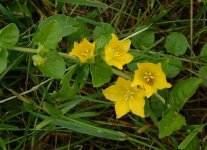Coarse grasshopper (meadow tea) - lysimachia nummularia l.
Family Primrose - Primulaceae
Botanical characteristics. Perennial herbaceous plant. Stems creeping up to 80 cm, tetrahedral, often rooted in nodes, slightly branched. Leaves opposite the rounded form (coin-like), hence the name of the plant, on the edge of the whole, on short petioles. The flowers are golden yellow, relatively large, single, axillary, five-dimensional, the cup is funnel-shaped, almost separate to the base. Blooms in June - July. The flowers are not pollinated, and in this connection, normally developed seeds are never formed. It reproduces mainly vegetatively.
Spread. It grows only in wet places: on mountain and flood meadows, on the outskirts of bogs, in thickets of bushes.
Used parts of the plant. The medicinal raw material is the whole plant. It is pulled out with a root during flowering and dried in the shade in a ventilated room. All parts of the plant contain saponins, tannins, carbohydrates, nitrogen-containing compounds, flavonoids: hyperin, rutin; Phenylcarboxylic acids and their derivatives, enzyme impurity, silicic acid.
Application. Verbeynik has long been used in folk medicine in the form of tea suffering from dust diseases of the lungs, which in the mornings are not able to clear their throats, get rid of mucus. Verbaine is often used in conjunction with the leaves of mallow.
Triturated leaves and fresh juice are applied to purulent wounds and long unhealed ulcers, with infiltrates, as wound healing, anesthetic, astringent and hemostatic, with dysentery, hemoptysis, hemorrhoids.
Infusions and decoctions are used for constipation, bruises, peptic ulcer, gynecological diseases, with anemia, headache, scurvy, jaundice, convulsions; Externally - in the form of drops - with nasal bleeding, eye diseases; Poultices - with tumors, bruises, hernias, rheumatism; Rinsing - with diseases of the oral cavity, stomatitis, skin inflammation, eczema, thrush.
Powder roots in the form of powders are used externally as a wound-healing, analgesic and hemostatic agent in the event of damage to blood vessels.
In Tibetan medicine widely used meadow tea with various gastrointestinal diseases. Fresh juice - with the bites of animals, snakes, insects both inside and outwardly. Young stems are used for food. With honey - when coughing, shortness of breath.
Preparation
- For broth take 20 g of the aboveground part or roots, chop, pour 200 ml of boiling water, insist on a boiling water bath for 30 minutes, cool for 10 minutes, without removing from the bath, filter. Take 1/3 cup 2-3 times a day before meals.
- For infusion of 15 g of flowers or leaves, pour 200 ml of boiling water, insist on a boiling water bath for 15 minutes, cool for 45 minutes, filter. Take 1/3 cup 2-3 times daily before meals.
- Fresh juice for nasal and eye drops should be diluted with water at a rate of 1: 1, inside - 1 teaspoon per 30 ml of water 2-3 times a day before meals.




Comments
Commenting on, remember that the content and tone of your message can hurt the feelings of real people, show respect and tolerance to your interlocutors even if you do not share their opinion, your behavior in the conditions of freedom of expression and anonymity provided by the Internet, changes Not only virtual, but also the real world. All comments are hidden from the index, spam is controlled.